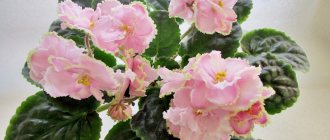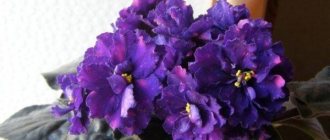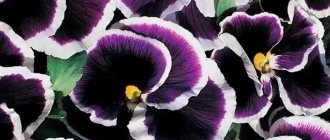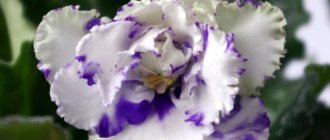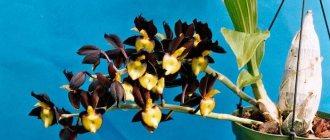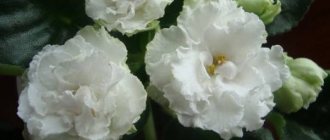There are legends around this violet and almost detective investigations are carried out; this is the Charming Eyes variety, at least the variety that is now popular under this name .
The appearance of this Saintpaulia is attractive, and for many collectors
it is important to know:
- Origin of the variety;
- Or the presenting breeder.
The charming eyes were created by a famous person among flower growers, the author of many classic and retro varieties of violets - B. Makuni . But the important question is that Saintpaulia, popular today, bears this name with a big question mark.
In the article you will see a photo and description of the variety.
Violet Charming eyes (B. Makuni)
Violets The charming eyes of Makuni have the following description (written during the author’s lifetime):
- Flower : Single;
- Star shaped;
- The edge of the petals is slightly wavy;
- The color is snow-white with a lilac spot in the center.
On the Internet, during the investigation, they found a clipping from an old newspaper, with an article by the Makuni spouses themselves, in which a photo of this variety was inserted . The Makuni variety is considered lost, so another violet is called by this name, and is often attributed to this breeder.
Found newspaper.
The variety belongs to the genus of hybrid Saintpaulias, the Gesneriev family. Most flower growers agree that this variety was bred from an industrial variety , but the history of its origin and author are unknown.
Saintpaulia rosette:
- Flat;
- Medium size;
- Neat;
- About 16 cm in diameter.
Violet leaf:
- Round;
- Finely toothed along the edge, on a short stalk.
The variety has an unusual leaf color.
Sheet color:
- Motley;
- Mosaic;
- Bright green with white.
Important! Variegation is more characteristic of young rosettes, and disappears in most individuals as they grow older.
Flowers of the variety in question:
- Quite large;
- Simple stars;
- Slightly bell-like;
- About 5 cm in diameter.
The color of the flowers is complex:
- The main color is considered blue and white;
- The edges of the flower are darker, bluer;
- And in the center there is an even darker peephole.
Depending on the conditions of detention and age, it may be more or less variegated. And the color of the flowers changes from lighter in cool weather to more saturated in hot weather. Sometimes the flowers can be blue with a blue edge and an even darker eye.
Diseases and pests
The “Winter Smiles” violet, like many indoor plants, is susceptible to all kinds of diseases. Here are the most common of them:
- Late blight.
- Powdery mildew.
- Fusarium.
- Gray rot.
Among the pests that violets may be susceptible to attack are:
- mites;
- scale insect;
- nematodes;
- aphid;
- woodlice;
- coccids;
- thrips;
- sciarids;
- whitefly;
- idiots.
To treat the listed diseases and get rid of pests, the plant is treated with special solutions, after removing the affected areas.
Caring for a plant at home
Suspicions about the industrial origin of the variety are confirmed by the unpretentiousness of the variety . The main points of care are classic for all Saintpaulias.
Conditions of detention
For good growth and development of the outlet, you do not need to create special conditions, just choose a suitable place:
- With bright lighting, without direct sunlight;
- Without drafts and temperature changes (range 18-24° depending on the season);
- Preferably with air humidity of about 60%.
Saintpaulia does not like direct sunlight.
Under such conditions, the outlet will be smooth and neat. Many gardeners recommend not making different temperatures when the season changes, but always maintaining it at 22-24°. Depending on the temperature conditions, the shade of colors may change.
In addition to a well-chosen habitat, it is important to create proper care, which includes interrelated factors:
- Watering – carried out by two main methods:
- Under the leaves or in the tray , water is added in one of two ways, while the frequency of watering and the basic principles are the same. Watering is carried out as the soil dries - about once a week in the summer and a little less often in the winter;
- Wick - water is constantly in a container under the pot and a wick (cord) from the flowerpot is lowered into it through the drainage holes at the bottom.
- Priming – you can simply buy a special substrate for Saintpaulia at a flower shop, but it is not as suitable for violets as one correctly composed at home, and besides, different watering requires different proportions. The main ingredients are:
- Peat, soil, perlite;
Or vermiculite and sphagnum moss, which is replaced with coconut fiber.
- Feeding – the frequency and concentration of mineral fertilizers also depends on the type of irrigation:
- For the classic procedure, the procedure is carried out through watering - approximately once every two weeks in the summer and a little less often in the winter, and the dosage recommended by the manufacturer is halved;
- For the wick version, fertilizers are constantly added to the water, and taking this into account, the concentration should be 7-8 times less than that indicated in the instructions.
For the first type of irrigation, the proportion is 1/1/1/0.3, and for the second - 1/0/1/0.1;
Attention! This variety is unpretentious in care, and even mistakes will not immediately lead to the death of the flower, but will only slightly spoil its appearance.
Reproduction, pruning, rejuvenation
For good development of Saintpaulia, it is necessary to remove damaged areas.
Constantly growing Saintpaulias constantly require pruning for hygiene purposes . To do this, cut:
- Old sheets;
- And faded flower stalks.
In addition, when transplanting, the pruning is made deeper, and the 2-3 lower rows of leaves are removed, and all the material, except the first row, is used further for propagation.
Transplantation is carried out as necessary, and the reason may be:
- Outgrowing the pot - the plant is simply transferred;
- Soil depletion - provided regular feeding is carried out quite rarely, and the earthen ball is completely replaced;
- Deepening - when the bare stem of the rosette rises too high above the pot, after replanting the violet usually remains in its pot, and the soil is replaced (sometimes it is necessary to trim the slightly underground part of the stem);
- Diseases - if Saintpaulia is sick, it should be replanted with a complete replacement of the soil and cleaning of the roots.
Reproduction and rejuvenation are very important aspects in floriculture, which are quite simple for violets. Old rosettes are usually rejuvenated using the method of rooting the apex :
- The growth point with several rows of leaves is cut off;
- Remove 1-2 rows at the bottom;
- Place the stem in water, soil or moss;
- After the roots appear (in water and moss), the rosette is planted back into the ground.
Reproduction is possible by all known methods:
- Rooting a leaf cutting:
- The sheet is taken from row 2-3;
- Rooting is carried out in water, moss or soil;
- In the first two options, they are planted in the ground after the roots or children appear (depending on the preferences of the grower);
- Children are seated as needed.
Most often, violets are propagated by leaves. - Rooting of the peduncle is carried out in the ground, under the film.
- Stepchildren are planted at an independent age (with their own roots), or rooted using one of the methods used for leaves.
Attention! Seeds can still be used for propagation, but this method, even if the variety is self-pollinating, can give many unexpected options, and is therefore usually used for breeding new varieties.
Reviews
Valentina Petrovna. “I’ve been collecting Makuni varieties for a long time. I really like the simplicity and at the same time charm of retro Saintpaulia. I bought Charming Eyes, I really liked it, the flowers are beautiful and the rosette itself is very smooth and beautiful. Disappointment only came when I realized that the variety was not quite right. When I accidentally found out that the Makuni variety had been lost, at first I didn’t understand how it was, and when I figured it out, I became upset.
The only joy is the beauty of the bush, which compensates for the bitterness of disappointment, now I’m trying to find a real variety.”
Violet Charming eyes attracts many gardeners.
Veronica Pavlovna. “I bought the variegated baby Charming Eyes, I really liked the pattern on the sheets. When it first bloomed, I was a little surprised by the number of flowers and their size. Very beautiful flowers, both in shape and color. It took her 8 months to reach an adult socket, but I don’t know how old she was when she bought it. The diameter of my rosette is 17 cm, which is very good for wick-irrigated Saintpaulia. The flowers are large, both blooms grow up to 6 cm.”
Makuni: good genius
There lived on this earth, among us, a kind man. The man's name was Boris Mikhailovich Makuni. There is no page about him on Wikipedia and no publications in the press. Although, this person is known all over the world, to every lover of indoor violets (Saintpaulias) and connoisseur of selection, to which the hero of my publication devoted almost half a century. Modern varieties of violets often convey varietal characteristics much worse than the varieties bred by Makuni.
They don’t name stars, streets, or even Saintpaulia varieties in his honor (I’m just ashamed of that). It’s just that the “grandfather of Russian violet selection” has always been modest. And he generously gave his flowers, including taking them to children's institutions and hospitals. He always delighted his family and friends with live bouquets. For the New Year, he also presented “floral carpets”: he poured water into an elegant plate and put picked flowers of various colors. Friends wrote:
Some people love stamps, some cats, some dogs. He loved to give violets for the holiday and just like that...
Then, when Makuni’s entire collection perishes in an apartment fire (his youngest son Denis, a talented artist and also a promising breeder, also perishes along with her), the Master’s legacy will remain alive only thanks to the fact that it was generously distributed, blossomed and multiplied on the windowsills. This sad story is like a parable with one moral: give, then you will be able to save... Those who had the good fortune to meet the Master in person remember that it was easy to enter this house. One saintpaulia collector said that he simply found a familiar surname in the telephone directory (fortunately, it is rare). Boris Mikhailovich and his wife Tatyana Nikolaevna welcomed the unexpected guest cordially, not at all bothered by the fact that he was a stranger.
What did he see during his visit? An ordinary three-room apartment in Yasenevo, a typical area of Moscow new buildings (a grateful resident named the variety in honor of the Yasenevo microdistrict). An elderly man who is open to communication - an Arbat Muscovite of the old stock. Two sons. A charming wife - a faithful life partner and a “violet Muse.” And thousands of violets on the shelves. Yes, the unassuming couple, even in the days of world triumph, when next to the varieties “from Makuni” at exhibitions in America and Japan there were signs “Russian superstar!”, did not acquire their own greenhouse. What did the Master tell his visitors (besides the fact that he willingly shared the secrets of cultivation)? Boris Mikhailovich owes his rare, unusual surname to an Italian ancestor, a soldier in the Napoleonic army. His ancestor almost froze to death in the Russian snows, but was saved by a charming peasant woman who invited him to her home. What follows is like in an old novel: love. wedding, children, grandchildren, birth. Makuni are not biologists: Boris Mikhailovich is a nuclear physicist, an employee of a research institute. Tatyana Nikolaevna is a women's costume designer, embroiderer and lacemaker. Relatives wrote about her like this:
Slender figure, long eyelashes. Tanya the lacemaker is knitting something again. A pattern of patterns curls on a white napkin, like on the best dress of the Snow Queen. (verse by Anna Skvortsova).
Then the Master will dedicate the variety to the memory of his lacemaker. And after that, people who find out that he is no longer here will think: why did he die? “Eat the atom” (after all, a nuclear scientist), or simply couldn’t live without his wife? They were a loving, friendly, surprisingly harmonious couple. Yin and Yang. Tatyana Nikolaevna is not just a tireless assistant, a wife-comrade, a wife-friend, but also a generator of ideas. They say that even my husband’s passion for violet selection began with her suggestion. Tatyana Nikolaevna loved to look at the flowers on the windowsills while walking around Moscow. One day, her husband gave her a strange blue-violet flower with the tag “Uzambara violet”, having found it with difficulty in one of the thrift stores and bought it with money that was almost too much for a researcher. Now these words “looked for”, “exorbitant money” sound strange - in any store there are heaps of these violets. And then it was the sixties, and it’s not that there was no domestic selection - in general, Saintpaulias were very rare. The second violet, a pink one, was given by a neighbor. Tatyana Nikolaevna suggested to her husband: “Why don’t we cross them?” The husband had a scientific, inquisitive mindset. Crossed. Happened. If Boris Mikhailovich had not listened to women’s advice, there would not have been such a breeder in our history, and the domestic violet selection itself, which began with Makuni, would have developed much later and would have been backward for a long time. The words “contributed” and “left a mark” are completely unnecessary here.
I once read the title “The Secret of the Makuni Family.” Yes, this simple and open family had no secrets! The secret of their success lay solely in love. And to each other, and to their green pets. They treated them as living, thinking and sensitive beings. Tatyana Nikolaevna spoke with excitement about how a violet suddenly died overnight, which they were simply advised to “drive in to pay off their debts.” And exactly on the fortieth day after the death of Boris Mikhailovich, one of his main hopes quickly blossomed like a cap of flowers. Yes, violets sense the state of the owner, his mood - I see this too. You look at them and the nervous tension and bad mood are gone. They relieve stress selflessly, without asking for anything in return. The whole family took care of the collection. The children watered the plants and helped name new varieties. Perhaps this is how the names “Hamster”, “Meows”, “Mistress of the Copper Mountain”, Pirate” and “Leopold the Cat” appeared. Everyone transported soil from the dacha together (at that time, soils for every taste and additives to them were not sold at every turn). I also want to say about the names of the varieties that, judging by them, their author had an extraordinary sense of humor and was kindly sharp-tongued. What are the values of “Merry Potassium Permanganate”, “Blyakha-Fly”, “Leshy” and “I Won’t Give to Anyone!” Here the stories are like this. The "fly-fly" tormented the breeder - it did not want to produce flowers of the desired "wasp" shape. In the hearts of the shrew, such an expressive name was given. “Goblin” was described by its creator as follows: “In this variety, the flowers peek out from under the foliage, like a goblin in the forest from under a bush.” With “I won’t give it to anyone!” it's almost a comedy. Seeing this violet in bloom, Tatyana Nikolaevna grabbed it and exclaimed: “I won’t give it to anyone!” She just wanted to keep her as her favorite. And the “snide” husband went ahead and immortalized her exclamation for many years. It is quite possible, by the way, that “Blyakha-fly” (the same emotional exclamation) was also the wife’s “answer” - she could also name the variety. If so, then interesting “family battles” - with warm irony.
Makuni, in general, has many “dedication varieties”. “In Memory of the Master”, “In Memory of Academician Vavilov”, “Galina Ulanova”, “Nina Karpovich”. And also “Lovely mother-in-law”, “Natasha”, “Ksyusha”, “Ah, Nastasya!”, “Aunt Asya”, “Albina”, “Larissa”, “Elena”. “Olesya”, “Semyonovna”, “In Memory of Tanya Makuni”, “Tatyana Nikolaevna”, “Tatyana’s Day”, “Petrovich”, “Seryozha”... It is only clear that Tanya, Tatyana Nikolaevna is the wife. “Natasha” - in honor of her granddaughter. I wonder who and where are all the other people? Do they remember? Do they have violets named after them, after them? What is known for certain is that Anton, the eldest son of the Makuni couple, does not have one. At all. He once wrote online that he was still hurt by the sudden and almost simultaneous loss of almost all his relatives (Boris Mikhailovich briefly outlived Tatyana Nikolaevna, and his son Denis also died soon). Anton Borisovich still cannot recover from this... He writes talented poems and humoresques, his granddaughter Natasha graduated with honors from the journalism department, and brilliantly tries her hand at the profession and poetry. So far, no one from the Makuni clan has continued the work they started. But for some reason I believe that this thread will not break. I also believe because this family’s talents are hereditary: Boris Mikhailovich was great at drawing, taking photographs and composing poetry - all this was passed on to his sons and granddaughter. Someday, in one of the generations, the “violet gene” will appear. Maybe the register will be accurate (no one still knows exactly the number of varieties bred by this family, including Denis), and a catalog and book will be published. However, about the book, the Master would probably ask: “Why?”
Author: Yulia Kobelnik
Features of flowering, growth and reproduction
The variety grows quite quickly, and the first flowering can be expected in 10-11 months. The rosette forms itself, even on the windowsill, and does not require additional lighting. With wick irrigation, the rosette may slightly outgrow its standard dimensions, but the size of the flowers may also increase.
The variety is propagated by all available methods, taking into account the absence of a chimeric pattern on the flowers. But propagation by peduncle or seeds may not transmit the variegation of leaves to the offspring .
The flowering is abundant, in a bouquet, but it can hardly be called a cap, because the flower stalks often fall on the leaves , being quite long and thin. The duration of flowering is very pleasing, each bud lasts from a week to two. Color depends on temperature:
- In hot weather, a darker shade of blue, and almost blue at the edges;
- In cool weather the flowering is light, almost white.
Attention! The size of the flowers is also pleasantly surprising; on a fairly small rosette, they are about 5 cm.
